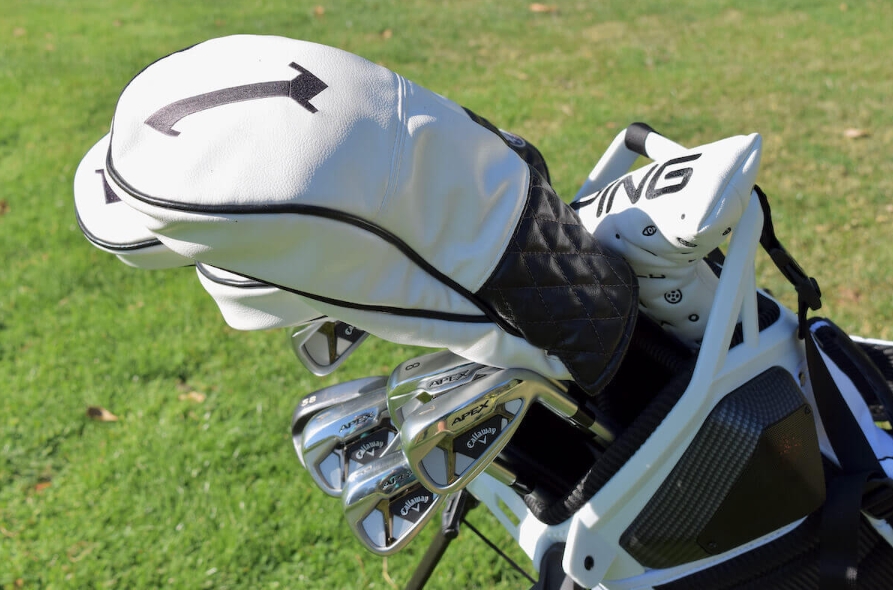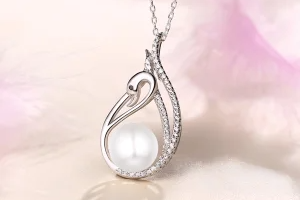Golf is a sport teeming with many unwritten rules, most of which are about the dress code and etiquette, whereas those related to carefully arranging one’s equipment often get overlooked.
Beyond the mere alignment of clubs, a well-ordered golf bag is a gateway to both psychological serenity and practical prowess on the course.
Combined with the sense of practicality, a neatly organized bag creates a tranquil concentration that offers clarity for taking those gorgeous shots.
This article untangles the intricate relationship between club setup and swing mastery, analyzing how to purposely place each club in a golf bag to impact your game significantly.
The Importance of Club Organization
Organizing your golf clubs in a careful sequence inside your bag is similar to conducting an orchestra during the course, where every note counts.
Choosing an organization structure from long to short and top to bottom is more than a mere organizing preference; the smartest choice for gameplay ensures your tools keep in place while you go.
The fact that the longest clubs are placed at the top facilitates convenience since they can easily be reached for those vital shots.
This simplifies your game and creates a mental picture, strengthening your recollection of club preference.
The descending order safeguards club shafts and heads against scratches or abuse that might weaken your investment throughout an event.
Organizational strategies also differ based on bag types. Mobile carry bags are made convenient by incorporating a simple design that helps in carrying.
On the other hand, hybrid bags, which are multifunctional, combine versatility with accessibility and security.
Cart bags are designed for riding on golf carts; some may even have separate compartments to make access during play easier.
By identifying the characteristics of compartment designs for each bag type, golfers can adjust their organization to match particular requirements.
This approach improves play efficiency and ensures that the delicate instruments necessary for your shot are protected, leading to a better and more successful time playing on the course.
Detailed Club Arrangement
Woods and Putter at the Top:
Positioning woods, hybrids, and putters at the top of your golf bag is a tactical move borne out of two objectives; protecting delicate graphite shafts and ensuring easy access during play.
The logic is derived from the fact that graphite shafts are very susceptible to damage expression when placed in a setting that includes the heft and sturdiness of other clubs.
In placing these clubs at the bag’s peak, minimizing, if not eliminating, all risks of contact leading up to chipping or cracking is possible.
At the same time, this setup allows golfers to get their favorite woods or putter in a split second while not interfering with play.
This well-considered system not only prolongs the life span of costly graphite shaft clubs but also has an easy ordering procedure on the golf course, which helps to cherish the golf experience.
Mid and Short Irons in the Middle:
The logical arrangement chain progresses to mid and short irons, occupying the central regions of a golfer’s golf bag.
This intentional placement ensures that the woods and putters down to shorter irons transition smoothly, thus making gameplay an easy methodical process.
Positioning mid irons in the center evenly distributes weight within the bag and provides a framework for choosing clubs.
From the top to bottom of a golfer’s club, the pattern replicates how shots are being played; it is rhythmic and in tune with what occurs during play.
This wise system not only improves the accessibility of particular clubs but also helps keep a clear vision of holes, leading to better shot execution and resultant performance.
Short Clubs at the Bottom:
The bag’s lower part is meant for wedges and short irons, where systematization plays an essential role in terms of convenience.
Positioning these short clubs bottom of the bag ensures adequate stability for balanced weight distribution and quick and unhindered retrieval in case of critical shots near the green.
Short wedges and short irons are commonly used for pinpoint, close-in shots, so having them down low allows golfers to easily find these clubs when they need this ammunition the most.
This form of organizational strategy creates a fluid and efficient style in the gameplay that allows golfers to navigate different scenarios easily.
Whether producing a soft chip shot or meticulous approach, the tactical placement of short clubs at its base heightens golfer agility in rapidly responding to different course challenges leading to an overall more solid game.
Protecting Your Clubs
The fragility of clubheads, with their exquisite designs and frequently costly materials, accentuates the need for quality headcovers.
In transit, the clubs rub together in their bag, which often causes cosmetic damage or even performance questions.
Moreover, headcovers offer a softer barrier to protect the club from accidental bumps and reduce friction-induced nicks or scratches.
While on the course, headcovers avert contact with other clubs, ground, and even occasional mishaps involving golf carts to ensure that your golf tools remain in good condition throughout.
When choosing which headcovers to use, you can consider the following factors:
- Material Matters: Pick headcovers that are strong and protective. Neoprene and leather are used because of their durability; they do not wear out.
- Individual Covers for Each Club: Consider using separate headcovers for each club, especially if handling woods and hybrids. This ensures absolute protection and prevents clubs from hitting against each other.
- Tailored Fit: Select head coverings that fit each club in custom. A close fit enhances protection and prevents covers from falling off during carriage.
- Ventilation for Hybrids and Putters: Choose headcovers with crazy shapes from clubs such as hybrids and putters showing multiple ventilation holes. It stops moisture development so clubs do not become moist and corrode.
- Easy Identification: Pick head covers with clear identifiers or a distinctive style for fast club identification. Moreover, it makes the club selection process much more enjoyable as you get to personalize your golf bag.
- Consider Travel Covers: Buy extra travel covers if you carry your clubs with you most of the time. These provide extra protection and padding for your clubs, especially during air travel or long-distance driving.
- Remove Covers Properly: Gently lift the headcovers to avoid accidentally hitting other clubs. Establish a routine to minimize the likelihood of needless accidents.
- Clean Regularly: Clean your headcovers often so they do not accumulate dirt or debris, which could cause the heads of clubs to scratch over time. Almost all headcovers are machine washable or can be wiped clean.
Maximizing Bag Storage
There are different pockets in a golf bag that have a variety of utilities to help you save time and money. Here are various pockets in a golf bag and what they carry:
1. Insulated Pockets for Drinks:
Insulated pockets on a golf bag offer double benefits—they preserve cold beverages and prevent condensation from occurring in other compartments.
It allows you to bring some cool drinks and ensure you stay hydrated on the field. Choose lightweight and reusable bottles for ease of use while keeping the bag relatively lighter overall.
2. Apparel Pockets:
Designed for storing clothing, apparel pockets can be used to carry extra layers of clothes, rain gear, or even changing clothes.
Pack some lightweight but compressible materials so you are ready regardless of the weather changes.
To even distribute the weight, you should place apparel in various pockets to ensure a balanced golf bag.
3. Valuables Pockets:
Valuable pockets provide a haven for items like keys, wallets, and watches. Use these pockets for small things to keep secure and within easy reach.
A small pocket could be attached to this space so that coins, tees, or ball markers would not clutter the area while continuing easy organization.
4. Accessory Pockets:
Accessory pockets are dynamic areas for items such as golf gloves, rangefinders, or small tools.
Put tons of accessories that improve your game and are not considered useless weight, which you can take.
Distribute weight with consideration, using heavier accessories towards the center of your bag to allow maximum balance and distribution.
5. Ball Pockets:
These pockets are dedicated to the golf balls and keep your supply organized so you can easily take some when needed.
Ensure you carry the minimum number of balls for a round, and avoid taking too many to reduce weight.
Distribute them evenly among various pocket areas of the coats or use a small pouch to keep them apart to reduce unnecessary noises during movement.
6. Club Dividers:
Club dividers are key factors in preventing club tangles and gaining easy access.
You can organize clubs systematically according to their kind and place the ones that share a certain type in close proximity.
This organization provides timely club retrieval during gameplay and has an even weight distribution for better ease of bag carrying.
7. Umbrella Sleeves:
Umbrella sleeves accommodate weather protection, allowing you to carry a compact umbrella for rain or sun
Pick a foldable umbrella that can be light slim, and collapsible because of storage.
Latch it into the sleeve so you do not get your other pockets interfered with, and maintain an even weight distribution in your golf bag.
Essential Golf Accessories
1. Towels
2. Rain Gear:
3. Umbrellas
4. Golf Tees
5. Divot Tools
6. Extra batteries and charger
7. Ball Markers
8. Golf Gloves
9. Scorecard Holder
10. Alignment Sticks
11. Rangefinder
12. Sunscreen
13. Bug Spray
14. Extra Golf Balls
15. Golf Club Brush
16. Personalized Golf Sack
The golf sack from us is an unusual trinket that provides a personalized touch to your game as it brings out the unique features in your bag, making it ideal for gifting golf players.
Customized with your name, these bags provide a personal touch to any golf set and act as an efficient playing ball storage bag.
To further ensure that your golf bag remains organized, accessible, and efficiently packed for an enjoyable round on the course, you need to follow the following storage suggestions:
- Categorize and Organize: Lump things in groups and make clearly defined compartments out for the various categories, such as, accessories or valuables.
- Use Pouches or Small Bags: Mini pouches or bags should be used for small items such as tees, ball markers, and divot tools. This keeps them from wandering away or filling the larger pockets with litter.
- Secure with Clips or Straps: Using clips or straps to help fit towels, umbrellas, and range finders into the right loops/rings on your golf cart prevents you from losing stuff.
- Consider a Bag Organizer: A bag organizer with several tiny compartments is a great accessory that can increase efficiency – everything will have its place and be accessible.
- Hang Towel Outside: Fasten the towel to one of those outside loops or simply clip it in, allowing quick access without occupying space on board.
- Invest in Multi-Pocket Bags: Choose bags that contain several individual pockets to prevent putting all accessories in one bag and sticking them together.
Maintenance Tips
A properly cleaned and well-maintained golf bag, clubs, etc., are tools used during the gameplay and investment made towards your playability on fairways.
The frequency of cleaning and straightening your equipment keeps them in the right condition with their value and makes you hassle-free golf gaming.
Below is maintenance advice that will assist you in cleaning and organizing your golf equipment as per the order of usage, thus simplifying decluttering.
1. Regular Cleaning:
Ensure you clean your golf bag and clubs often to ensure longevity. Clean the bag with a soft brush if the bag’s surface is soiled and covered with dirt or other debris.
For clubs, use a brush to remove the grass and sand from club faces. To prevent dropdown off the grips, wipe it down with a damp cloth using mild soap
2. Inspect Zippers and Pockets:
Also, check out your golf bag’s zippers and seams for signs of stress or fault.
Ensure that all zippers are in order and deal with the problems of damaged materials promptly.
Make sure to clean and inspect each pocket regularly to pull out all the accumulated particulates or any debris that might be present.
3. Club Groove Maintenance:
The most desirable result on your clubface can be achieved if you maintain clean grooves. Apply a tee or specialized groove cleaning tool to scrub dirt and grass away from between the ridges.
This results in closer clubface contact that, in turn, manifests higher accuracy and increased and controlled spin.
4. Grip Care:
Check your club grips periodically for wear, cracking, or slipping. Wash them with a gentle soap and water mixture to remove dirt. This will help preserve its texture.
Grip the club whenever it is necessary to ensure that a firm and comfortable grip can be maintained during swings
5. Decluttering the Bag:
From time to time, go through the bag and get rid of items you no longer use or may not need. This way, keep your load manageable and ease accessibility for necessities
Drop unnecessary items, expired snacks, or old scorecards. Rethink the gadgets that you are accustomed to using, so they would make sense and ease your gameplay.
6. Protective Covers:
Have headcovers for the woods, hybrids, and putters when carrying them in your bag to avoid scratches or dings.
This simple maintenance allows clubs to be maintained in terms of appearance with little or no loss of value.
7. Avoid Wet Conditions:
Do not expose your golf bag to a wet environment if it can be avoided. It is advisable to let the club bag completely dry before putting it in your clubs.
The increased moisture can lead to mildew and molds growing, thus damaging both the bag and clubs.
8. Storage Considerations:
The clubs should be kept in a cool, dry place to prevent unnecessary and undesirable aging processes.
Don’t keep them in the boot for long periods either, particularly when it is hot outside, as high temperatures can impact both the materials and functionality of the bag and clubs.
FAQs About Golf Bag Organization
1. In a 14-compartment golf bag, how should I compartmentalize my clubs?
A 14-compartment golf bag has adequate space for every club, eliminating tangling and allowing easy access.
First, arrange the wood, hybrids, and putter on top for protection and ease of access. Arrange the mid and short irons between these sections, naturally moving from longest to smallest.
Keep the bottom for wedges and short irons. Use dividers so the clubs do not encroach on each other and prevent injuries.
2. Can I adjust the arrangement of my 14-compartment bag based on how well I play?
Absolutely. Tailor your bag for better organization according to how you play and prefer.
While some golfers arrange clubs by category, others organize them according to the order of swings they most often use.
Experiment with various arrangements to ascertain a fulfilling option convenient on the pitch and facilitate a simple selection of clubs during games.
3. How many clubs can I have in my bag at a round?
Based on the Rules of Golf, you can carry not more than 14 clubs during a round. This rule guarantees the evenness of play and has all golfers use the same equipment.
Choosing the right clubs is essential depending on what course you’re playing, your play style, and shots that are comfortable for each individual to undertake.
4. Are the golf ball retrievers considered clubs in my bag?
No, golf ball retrievers do not qualify as clubs when calculating whether you comply with the 14-club restriction.
However, it’s important to note that although ball retrievers are used during golf, they should no longer be above 15 feet.
Making good use of a retriever stops you from getting undeserved penalty strokes and helps you fetch balls that are in danger.
5. Can I combine clubs from various brands in my bag?
Yes, you can put clubs from different brands in your bag. Golfers tend to select clubs that do not conform to the norm of brand loyalty but primarily consider specific performance factors.
At the same time, one should pay attention to how shaft flex matches with club lengths and other features that provide for a well-balanced set.
By testing and fitting clubs before buying, you will get a good balance that should work well for your golfing style.
6. Are there advantages of using sets from the same brand?
Though there are no set rules regarding using the same brand to have a similar feel and look throughout their bag, some golfers prefer it.
Clubs from the same brand may have a similar design and share technologies concerning shafts, giving an uninterrupted feeling throughout clubs.
But the key component is to find clubs that fit your swing and preferences regardless of brand.
7. Can you use your golf bag for walking and riding on a cart?
Certainly, many golf bags have been designed for walking on the course and riding on a cart.
Seek bags with options, like shoulder straps with padding for carrying comfortably and cart straps to ensure secure attachment on a golf cart.
Hybrid bags are purposely meant to offer convenience as they provide significant storage space and allow compatibility for walking or use in a cart.
8. How can I organize non-club accessories inside my golf bag?
Create subcategories and designate individual pockets into different categories for a quicker organizational process of non-club accessories.
Consider using pouches or small containers for the smaller items to avoid cluttering. From time to time de-clutter your bag, removing unwanted items so you can have a workable weight.
Final Thoughts
In the complex dance between golfer and course, your golf bag’s organization becomes a silent conductor, creating both convenience and an entire symphony of increased performance.
The seemingly ordinary activity of club organization is a platform to discover deeper meaning in the game.
Beyond the convenience of immediate access and club safeguarding, an orderly bag in hand becomes a metaphorical compass leading golfers through terra incognita on each hole with ease.
A systematic approach for golfers helps them pace and structure their decision-making within the game and develop a space where they can find peace.
The choice of pockets, the precise placement of valuables, and the careful utilization of pockets add to a balanced golfing adventure.
Ultimately, the ordered golf bag represents a golfer’s passion for high accuracy through preparation and respect for every detail in this game.




